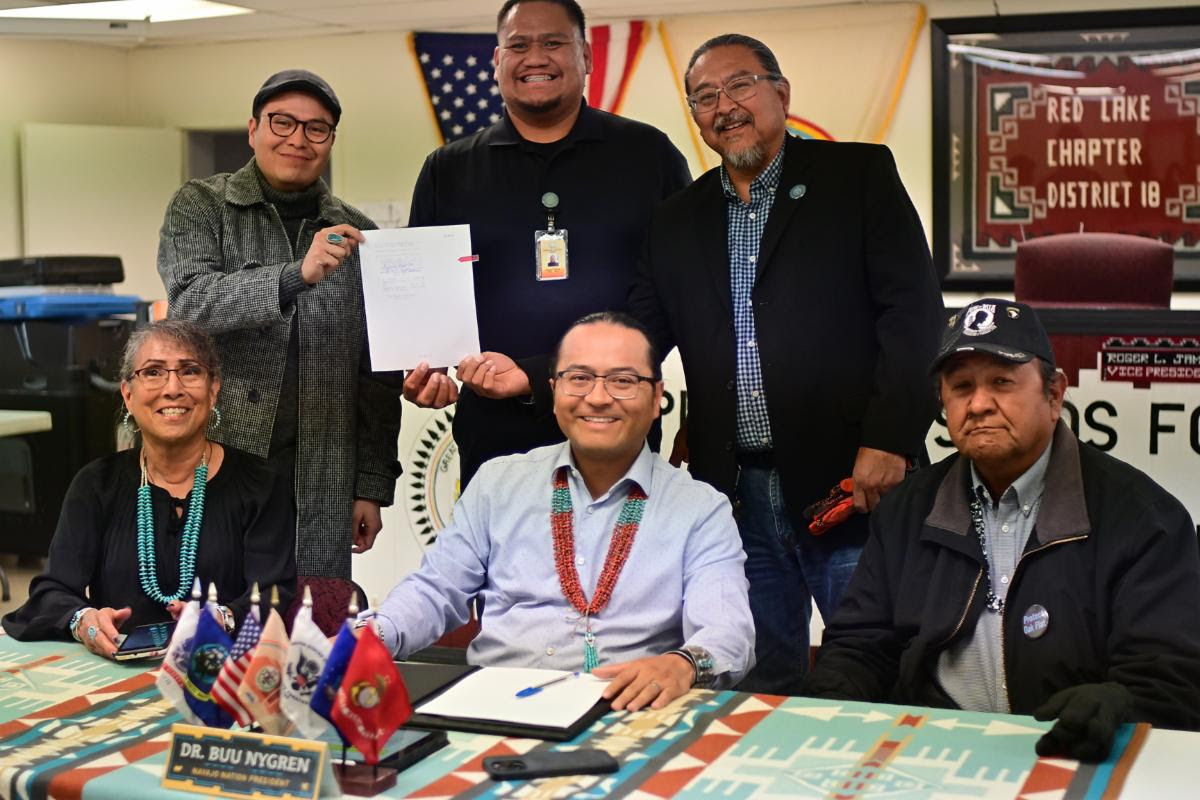
- Details
- By Native News Online Staff
On Thursday, Council Delegate Dr. Andy Nez joined Navajo Nation President Dr. Buu Nygren at the Red Lake Chapter as he signed Legislation 0149-24, establishing the Navajo Nation Remediation Fund to provide dedicated funding for cleaning up contaminated sites throughout the Navajo Nation.
Sponsored by Dr. Nez and passed during the 2024 Fall Council Session, Legislation 0149-24 creates the Navajo Nation Environmental Remediation Fund. This fund is sustained through an automatic two-percent allocation from the General Fund, enabling ongoing financial support for remediation efforts led by the Navajo Environmental Protection Agency (NEPA) and its contractors. The fund’s purpose is to identify, assess, and clean up former business and industrial sites on the Navajo Nation that have been contaminated with hazardous chemicals, which pose risks to public health, livestock, crops, groundwater, and the environment.
Ahead of the signing, Dr. Nez met with President Nygren to discuss the significant impact this legislation will have on communities like Sawmill, Red Lake, and others across the Navajo Nation.
“One of the main things about this legislation is that it ensures the protection, longevity, and importance of our land. Over time, there have been a lot of different businesses, whether commercial or industrial, that have disrupted our land,” Council Delegate Dr. Nez said. “The intent of this legislation is to address these issues. When we talk about business sites, it’s the contamination efforts that we’re helping clean up through remediation efforts.”
The signing at Red Lake Chapter held particular importance, given its proximity to the former Navajo Forest Products Industry (NFPI) site, which has been closed for over 25 years but remains heavily contaminated from its operational past. Dr. Nez recalled introducing initial legislation to address the NFPI site on November 30, 2023.
“At that time, I mentioned that these efforts and this legislation are for our future generations. We want them to grow up in space and land that is not only beautified but has potential for different opportunities,” he said. “The establishment of the Navajo Nation Remediation Fund is part of a greater economic plan
NEPA Executive Director Stephen Etsitty praised the collaborative efforts of the chapters involved in ensuring a solution to a pressing need. “An exciting thing for me is to get the cleanup going. Section by section, we can get the land in shape for reuse,” Director Etsitty said. “Who knows what the children of the future will be able to use this land for once it’s cleaned up.”
Dr. Nez expressed gratitude to all those who contributed to the development of this legislation, including the Crystal, Fort Defiance, Red Lake, and Sawmill Chapters; former NEPA Remedial Project Manager Pam Maples; Executive Director of the Navajo Townsite Community Development Corporation Prestene Garnenez; NEPA Executive Director Stephen Etsitty; and NEPA Waste Regulatory and Compliance Department Manager Warren Roan.
More Stories Like This
Native News Weekly (August 25, 2024): D.C. BriefsUS Presidents in Their Own Words Concerning American Indians
Indigenous Actor Elaine Miles Reports Detention by Alleged ICE Agents
Happy Thanksgiving from Native News Online
Coming Up on Native Bidaské: Behind the Animation: Joey Clift Talks “Pow” and Native Storytelling
Help us tell the stories that could save Native languages and food traditions
At a critical moment for Indian Country, Native News Online is embarking on our most ambitious reporting project yet: "Cultivating Culture," a three-year investigation into two forces shaping Native community survival—food sovereignty and language revitalization.
The devastating impact of COVID-19 accelerated the loss of Native elders and with them, irreplaceable cultural knowledge. Yet across tribal communities, innovative leaders are fighting back, reclaiming traditional food systems and breathing new life into Native languages. These aren't just cultural preservation efforts—they're powerful pathways to community health, healing, and resilience.
Our dedicated reporting team will spend three years documenting these stories through on-the-ground reporting in 18 tribal communities, producing over 200 in-depth stories, 18 podcast episodes, and multimedia content that amplifies Indigenous voices. We'll show policymakers, funders, and allies how cultural restoration directly impacts physical and mental wellness while celebrating successful models of sovereignty and self-determination.
This isn't corporate media parachuting into Indian Country for a quick story. This is sustained, relationship-based journalism by Native reporters who understand these communities. It's "Warrior Journalism"—fearless reporting that serves the 5.5 million readers who depend on us for news that mainstream media often ignores.
We need your help right now. While we've secured partial funding, we're still $450,000 short of our three-year budget. Our immediate goal is $25,000 this month to keep this critical work moving forward—funding reporter salaries, travel to remote communities, photography, and the deep reporting these stories deserve.
Every dollar directly supports Indigenous journalists telling Indigenous stories. Whether it's $5 or $50, your contribution ensures these vital narratives of resilience, innovation, and hope don't disappear into silence.
 The stakes couldn't be higher. Native languages are being lost at an alarming rate. Food insecurity plagues many tribal communities. But solutions are emerging, and these stories need to be told.
The stakes couldn't be higher. Native languages are being lost at an alarming rate. Food insecurity plagues many tribal communities. But solutions are emerging, and these stories need to be told.
Support independent Native journalism. Fund the stories that matter.
Levi Rickert (Potawatomi), Editor & Publisher

